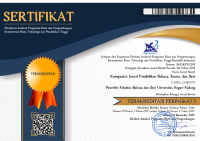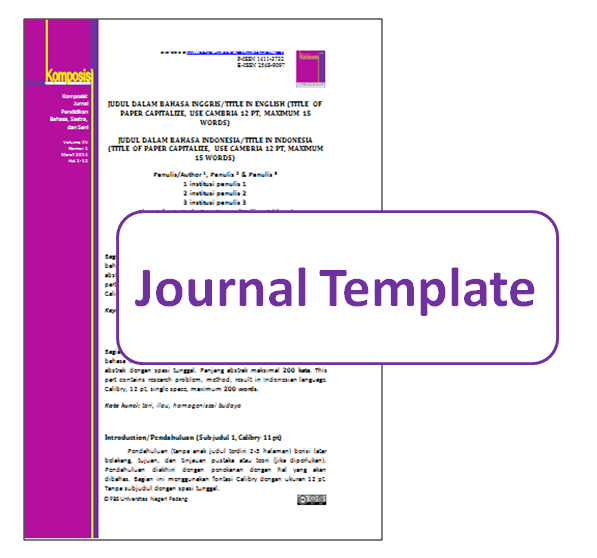STUDENTS’ PARAPHRASING ABILITY IN ACADEMIC WRITING; TECHNIQUES AND CHALLENGES
 ), Ainul Addinna(2), Rifky Oktoviandry(3),
), Ainul Addinna(2), Rifky Oktoviandry(3), (1) (SINTA ID. 6669833), Universitas Negeri Padang, Padang, West Sumatra
(2) Universitas Negeri Padang
(3) Universitas Negeri Padang
 Corresponding Author
Corresponding Author
Copyright (c) 2022 Komposisi: Jurnal Pendidikan Bahasa, Sastra, dan Seni
DOI : https://doi.org/10.24036/komposisi.v23i2.119456
Full Text:
 Language : en
Language : en
Abstract
In higher education, the demand of research publication is steadily growing. Due to this fact, the skills to write academic paper must be improved as well. One of the foremost skills required in writing academic paper is paraphrasing. This qualitative study investigates the most frequents paraphrasing techniques used by students and their challenges during the paraphrasing process. Thirty students enrolled in Academic Writing class participated in this research. The participants were required to do paraphrasing task, and 8 selected students (4 more proficient students and 4 less proficient students) would be interviewed in regards to their challenges in paraphrasing and how they dealt with such challenge. The result of paraphrasing task unveiled that most strategies used by students were “change to synonym”, “change to active to passive form” and a combination of these two. In regards to the challenges, reading, lexical and syntactic problems are the main challenges addressed by participants.
Keywords
References
Akbar, M. T. (2020). Students’ paraphrasing skill in literature review section of research proposal. Jambura Journal of English Language Teaching and Literature, 1 (1), 1-15.
Bailey, S. (2017). Academic writing: A handbook for international students. Routledge.
Day, M. (2009). A meshing of minds: the future of online research for print and electronic publication. New words: Exploring Pathways for writing about and in Electronic Environments, 251-277.
Hagaman, Casey & Reid. (2012). The effect of paraphrasing strategy on reading comprehension of Young Students. Remedial and Special Education, 33(2), 110-123.
Hayuningrum, H., & Yulia, M. F. (2017). Students’ problems in writing paraphrases in research paper writing class. Language and Language Teaching Journal, 15(01), 133–148.
Howard, R.M., Serviss, T, & Rodrigue, T.K. (2010). Writing from sources, writing from sentences,” Writing & pedagogy, 2(2).
Ismail, Sanubi, Halidin, Amzah, Nanning, & Kaharuddin. (2020). Paraphrasing technique to develop skill for English writing among Indonesian college students of English, SysRev Pharm, 11 (11), 291-297.
Jiang, H., Emmerton, L., & McKange, L. (2013). Academic integrity and plagiarism: a review of the influences and risk situations for health students,” Higher Education Research and Development, 32(3), 369-380.
Keck, C. (2006). The use of paraphrase in summary writing: A comparison of L1 and L2 writers. Journal of Second Language Writing, 15(4), 261-278
Khairunnisa, W., Sutapa, Y. G., & Surmiyati. (2014). Students’ Problems in Paraphrasing. Jurnal Pendidikan Dan Pembelajaran, 3, 1–9.
Kher, D. F., & Rani, Y. A. (2018). The Quality of Students’ Paraphrase of an Expository Text; A study of 15 English Department Students of State University Padang. Advances in Social Science, Education and Humanities Research, 276, 1-7.
Khrismawan, B., & Widiati, U. (2013). Students’ perceptions about paraphrasing and their cognitive processes in paraphrasing. TEFLIN Joutnal, 24(2), 135–157.
Lestari, S. B. (2014). Paraphrasing in High-scoring and Low-scoring L2 Integrated Writing Test Task Responses (Master’s thesis). Retrieved from
file:///D:/Thesis/Paraphrase%20Writing%20Skill/Reading%20Materials/APA/Apastyle.pdf
Liao, M. T., & Tseng, C. Y. (2010). Students' behaviors and views of paraphrasing and inappropriate textual borrowing in an EFL academic setting. Pan-Pacific Association of Applied Linguistics, 14(2), 187-211
Mariani, Rahayu, P.S., & Nor, H. (2021). Paraphrasing Strategies in Higher Education. Proceeding International Conference on Education of Suryakancana¸ retrieved from
https://www.researchgate.net/publication/354688010_PARAPHRASING_STRATEGIES_IN_HIGHER_EDUCATION
Milićević, J., & Tsedryk, A. (2011). Assessing and Improving Paraphrasing Competence in FSL. Proceedings of the 5th International Conference on Meaning-Text Theory [Recurso electrónico], retrieved from
https://www.researchgate.net/publication/349089449_Assessing_and_Improving_Paraphrasing_Competence_in_FSL.
Mira, S.M., & Fatimah, S. (2020). Student’s paraphrased text and their perception of paraphrasing in academic writing”. Lingua Didaktika, 14(1), 55-69.
Na C.D., & Mai, N.X. N. C. (2017). Paraphrasing in Academic Writing: A case Study of Vietnemess Learners of English. Language Education in Asia. 8 (1), 9-24.
Vandermey, R., Meyer, V., Rys, J. Van, & Sebranek, P, (2012). The college writer brief: A guide to thinking , writing , and researching (Fourth; M. Eckman, M. Leslie, J. Fifer, A. Haines, E. Ramsey, & J. Tangney, Eds.). Boston: Wadsworth Cengage Learning.
 Article Metrics
Article Metrics
 Abstract Views : 2136 times
Abstract Views : 2136 times
 PDF Downloaded : 118 times
PDF Downloaded : 118 times
Refbacks
- There are currently no refbacks.
Copyright (c) 2022 Komposisi: Jurnal Pendidikan Bahasa, Sastra, dan Seni

This work is licensed under a Creative Commons Attribution-NonCommercial 4.0 International License.











